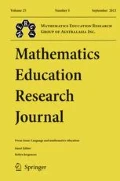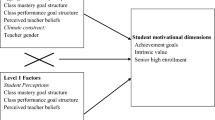Abstract
This longitudinal study examined relationships between student-perceived teaching for meaning, support for autonomy, and competence in mathematic classrooms (Time 1), and students’ achievement goal orientations and engagement in mathematics 6 months later (Time 2). We tested whether student-perceived instructional characteristics at Time 1 indirectly related to student engagement at Time 2, via their achievement goal orientations (Time 2), and, whether student gender moderated these relationships. Participants were ninth and tenth graders (55.2% girls) from 46 classrooms in ten secondary schools in Berlin, Germany. Only data from students who participated at both timepoints were included (N = 746 out of total at Time 1 1118; dropout 33.27%). Longitudinal structural equation modeling showed that student-perceived teaching for meaning and support for competence indirectly predicted intrinsic motivation and effort, via students’ mastery goal orientation. These paths were equivalent for girls and boys. The findings are significant for mathematics education, in identifying motivational processes that partly explain the relationships between student-perceived teaching for meaning and competence support and intrinsic motivation and effort in mathematics.



Similar content being viewed by others
Notes
The ICC1 values were calculated from the 46 classrooms (average cluster size: 15.96).
References
Attard, C. (2013). If I had to pick any subject, it wouldn’t be maths: foundations for engagement with mathematics during the middle years. Mathematics Education Research Journal, 25(4), 569–587.
Ames, C. (1992). Classrooms: goals, structures, and student motivation. Journal of Educational Psychology, 84(3), 261–271.
Barron, K. E., & Harackiewicz, J. M. (2003). Revisiting the benefits of performance-approach goals in the college classroom: exploring the role of goals in advanced college courses. International Journal of Educational Research, 39(4), 357–374.
Benjamini, Y., & Hochberg, Y. (1995). Controlling the false discovery rate: a practical and powerful approach to multiple testing. Journal of the Royal Statistical Society, 57(1), 289–300.
Brown, T. A. (2015). Confirmatory factor analysis for applied research. New York: Guilford Publications.
Byrne, B. M. (1989). Multigroup comparisons and the assumption of equivalent construct validity across groups: methodological and substantive issues. Multivariate Behavioral Research, 24(4), 503–523. doi:10.1207/s15327906mbr2404_7.
Clausen, M. (2002). Unterrichtsqualität: Eine Frage der Perspektive? [Quality of classroom learning environments - a question of perspective?] (Vol. 29, Rost, d.). Münster: Waxmann
Elliot, A. J. (1997). Integrating the “classic” and “contemporary” approaches to achievement motivation: a hierarchical model of approach and avoidance achievement motivation. In M. Maehr & P. Pintrich (Eds.), Advances in motivation and achievement (Vol. 10, pp. 243–279). Greenwich, CT: JAI Press.
Elliot, A. J. (1999). Approach and avoidance motivation and achievement goals. Educational Psychologist, 34(3), 169–189. doi:10.1207/s15326985ep3403_3.
Elliot, A. J., & McGregor, H. A. (2001). A 2× 2 achievement goal framework. Journal of Personality and Social Psychology, 80(3), 501–519. doi:10.1037/0022-3514.80.3.501.
Fredricks, J. A., Blumenfeld, P. C., & Paris, A. H. (2004). School engagement: potential of the concept, state of the evidence. Review of Educational Research, 74(1), 59–109.
Gherasim, L. R., Butnaru, S., & Mairean, C. (2013). Classroom environment, achievement goals and maths performance: gender differences. Educational Studies, 39(1), 1–12. doi:10.1080/03055698.2012.663480.
Hair, J. F., Anderson, R. E., Tatham, R. L., & Black, W. C. (1998). Multivariate data analysis. Upper Saddle River, NJ: Prentice Hall.
Hattie, J. (2009). Visible learning: a synthesis of meta-analyses in education. London: Routledge.
Hu, L., & Bentler, P. M. (1999). Cutoff criteria for fit indexes in covariance structure analysis: conventional criteria versus new alternatives. Structural Equation Modeling: A Multidisciplinary Journal, 6(1), 1–55. doi:10.1080/10705519909540118.
Lazarides, R., & Rubach, C. (2015-2016). Motivation and learning in mathematics. http://www.uni-potsdam.de/schulpaedagogik/forschungsprojekte/motivation-in-der-schule.html: University of Potsdam.
LeBreton, J. M., & Senter, J. L. (2008). Answers to 20 questions about interrater reliability and interrater agreement. Organizational Research Methods, 11(4), 815–852. doi:10.1177/1094428106296642.
Little, T. D. (2013). Longitudinal structural equation modeling. New York: Guilford Press.
Marsh, H. W., Lüdtke, O., Nagengast, B., Trautwein, U., Morin, A. J., Abduljabbar, A. S., et al. (2012). Classroom climate and contextual effects: conceptual and methodological issues in the evaluation of group-level effects. Educational Psychologist, 47(2), 106–124.
Middleton, J. A., & Spanias, P. A. (1999). Motivation for achievement in mathematics: findings, generalizations, and criticisms of the research. Journal for Research in Mathematics Education, 30(1), 65–88. doi:10.2307/749630.
Midgley, C., Maehr, M. L., Hruda, L. Z., Anderman, E., Anderman, L. H., Freeman, K. E., et al. (2000). Manual for the patterns of adaptive learning scales. Ann Arbor, Michigan: University of Michigan.
Müller, F. H., Hanfstingl, B., & Andreitz, I. (2007). Skalen zur motivationalen Regulation beim Lernen von Schülerinnen und Schülern. Adaptierte und ergänzte Version des Academic Self-Regulation Questionnaire (SRQ-A) nach Ryan & Connell. [Scales for the assessment of students' motivational regulation in learning processes. Adapted and expanded version of the Academic Self-Regulation Questionnaire (SRQ-A) by Ryan & Connell]. Wissenschaftliche beiträge aus dem institut für unterrichts- und schulentwicklung (ius) [scientific reports of the institute for school developement] (Vol. 1). Klagenfurt: Institut für Unterrichts- und Schulentwicklung (IUS), Universität Klagenfurt.
Muthén, L., & Muthén, B. (1998-2010). Mplus user's guide. Los Angeles, CA: Muthen & Muthen.
Patrick, H., Ryan, A. M., & Pintrich, P. R. (1999). The differential impact of extrinsic and mastery goal orientations on males' and females' self-regulated learning. Learning and Individual Differences, 11(2), 153–171. doi:10.1016/S1041-6080(00)80003-5.
Patrick, H., Ryan, A. M., & Kaplan, A. (2007). Early adolescents' perceptions of the classroom social environment, motivational beliefs, and engagement. Journal of Educational Psychology, 99(1), 83–98. doi:10.1037/0022-0663.99.1.83.
Pintrich, P. R. (2000). Multiple goals, multiple pathways: the role of goal orientation in learning and achievement. Journal of Educational Psychology, 92(3), 544–555. doi:10.1037/0022-0663.92.3.544.
Preacher, K. J., & Hayes, A. F. (2004). SPSS and SAS procedures for estimating indirect effects in simple mediation models. Behavior Research Methods, Instruments, and Computers, 36(4), 717–731.
Rakoczy, K. (2008). Motivationsunterstützung im Mathematikunterricht – Unterricht aus der Perspektive von Lernenden und Beobachtern [Motivational support in class] (Pädagogische Psychologie und Entwicklungspsychologie). Münster: Waxmann.
Reeve, J., & Jang, H. (2006). What teachers say and do to support students' autonomy during a learning activity. Journal of Educational Psychology, 98(1), 209–218. doi:10.1037/0022-0663.98.1.209.
Ryan, R. M., & Deci, E. L. (2000). Intrinsic and extrinsic motivations: classic definitions and new directions. Contemporary Educational Psychology, 25(1), 54–67. doi:10.1006/ceps.1999.1020.
Sierens, E., Vansteenkiste, M., Goossens, L., Soenens, B., & Dochy, F. (2009). The synergistic relationship of perceived autonomy support and structure in the prediction of self-regulated learning. British Journal of Educational Psychology, 79(1), 57–68. doi:10.1348/000709908X304398.
Sullivan, P., Clarke, D., & Clarke, B. (2009). Converting mathematics tasks to learning opportunities: an important aspect of knowledge for mathematics teaching. Mathematics Education Research Journal, 21(1), 85–105.
Tsai, Y.-M., Kunter, M., Lüdtke, O., Trautwein, U., & Ryan, R. M. (2008). What makes lessons interesting? The role of situational and individual factors in three school subjects. Journal of Educational Psychology, 100(2), 460–472. doi:10.1037/0022-0663.100.2.460.
Urdan, T. (1997). Achievement goal theory: past results, future directions. In M. Maehr & P. Pintrich (Eds.), Advances in motivation and achievement (Vol. 10, pp. 99–141). Greenwich, CT: JAI.
Waldis, M., Buff, A., Pauli, C., & Reusser, K. (2002). Skalendokumentation zur Schülerinnen-und Schülerbefragung im schweizerischen Videoprojekt [Scale documentation for the student questionnaire in the swiss video project]. Zürich: Universität Zürich: Pädagogisches Institut.
Watt, H. M. G. (2016). Gender and motivation. In K. Wentzel & D. Miele (Eds.), Handbook of motivation at school (pp. 320–339). New York, London: Routledge.
Acknowledgements
We wish to acknowledge the helpful and detailed comments on our manuscript, from Professor Helen Watt, Monash University.
Author information
Authors and Affiliations
Corresponding author
Appendices
Appendix 1
Appendix 2
Appendix 3: Mean Level Differences
With the condition of partial scalar invariance met, latent factor mean differences between girls and boys could be estimated. Because the latent means were set at zero for boys, the estimated latent means for girls represented their latent mean differences relative to boys. The Simes procedure was used to correct for the inflated risk of falsely rejecting the null hypothesis that results from multiple comparison procedures (Benjamini and Hochberg 1995). The kappa values of the model represent the latent mean parameters (Brown 2015). The latent mean differences provide information that exceeds the information from the later reported structural equation model as no other variables are considered in the model. Girls and boys did not statistically significantly differ in their mastery goal orientation (Time 1: κ = 0.14, p = .15; Time 2: κ = 0.18, p = .06), performance-approach goal orientation (Time 1: κ = −0.16, p = .09; Time 2: κ = −0.14, p = .08), effort (Time1: κ = 0.13, p = .02; Time 2: κ = 0.08, p = .22), and perceived teaching for meaning (Time1: κ = 0.17, p = .02) and competence support (Time1: κ = 0.21, p = .05). Girls reported statistically significantly lower autonomy support at Time 1 (κ = −0.19, p = .01) and lower intrinsic motivation (Time 1: κ = −0.38, p < .001; Time 2: κ = −0.33, p < .001). Girls’ (M = 4.08, SD = 0.99), and boys’ (M = 4.01, SD = 1.08) self-reported mathematics achievement did not statistically significantly differ, t (724) = −.92, p = .36.
Appendix 4: Intercorrelations among the independent variables
The following significant (p < .05) correlations among the independent variables are not depicted in Fig. 1: Int1 with Gender φ = −.24; EffT1 with Gender φ = .11; Mast T1 with Gender φ = −.12; PerfT1 with Gender φ = −.09; Achievement with Effort T1 φ = .16; Achievement with Perf T1 φ = .06; Int T1 with Eff T1 φ = .51; Int T1 with Mast T1 φ = .63; Int T1 with Perf T1 φ = .20; Eff T1 with MastT1 φ = .47; Eff T1 with Perf T1 = .22; Mast T1 with Perf T1 = .36.
Rights and permissions
About this article
Cite this article
Lazarides, R., Rubach, C. Instructional characteristics in mathematics classrooms: relationships to achievement goal orientation and student engagement. Math Ed Res J 29, 201–217 (2017). https://doi.org/10.1007/s13394-017-0196-4
Received:
Revised:
Accepted:
Published:
Issue Date:
DOI: https://doi.org/10.1007/s13394-017-0196-4




